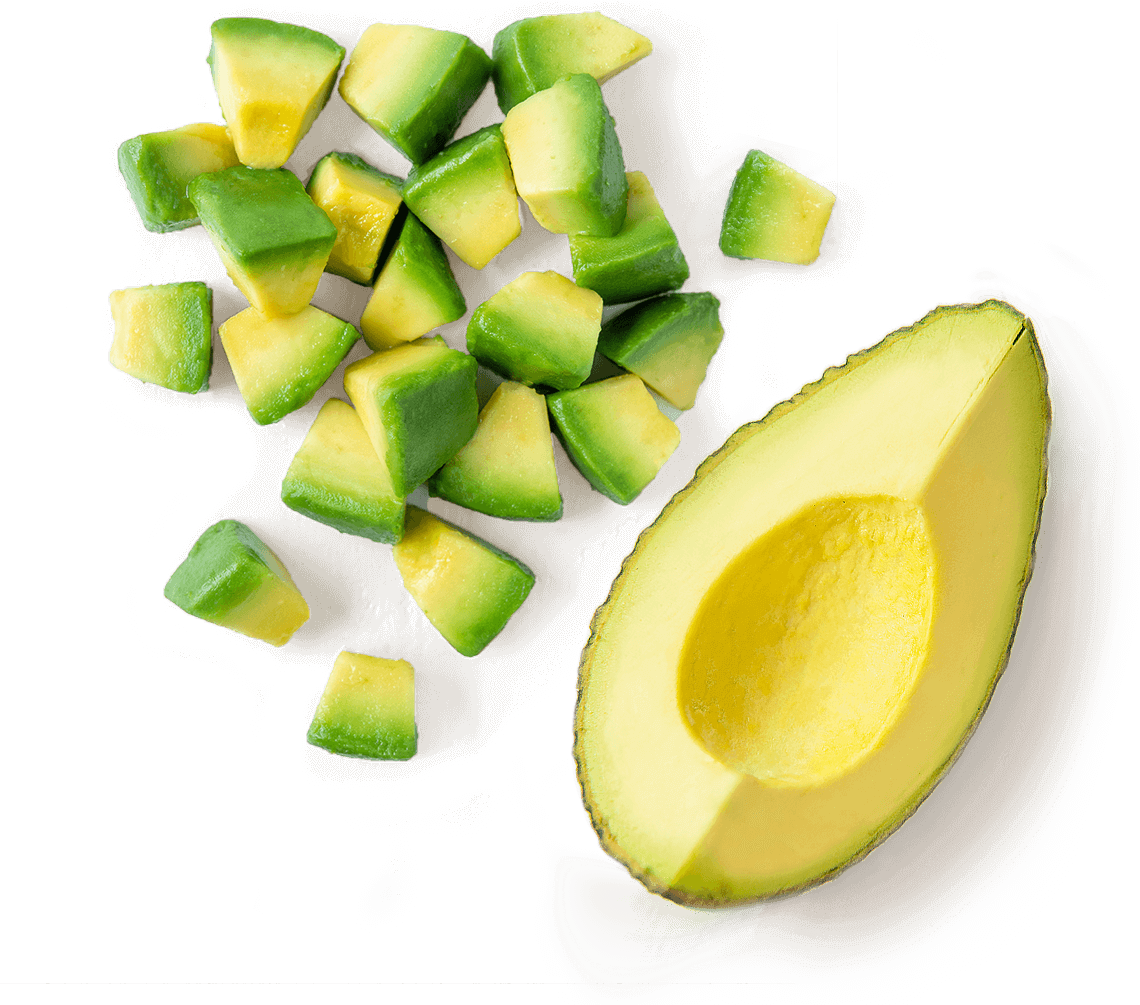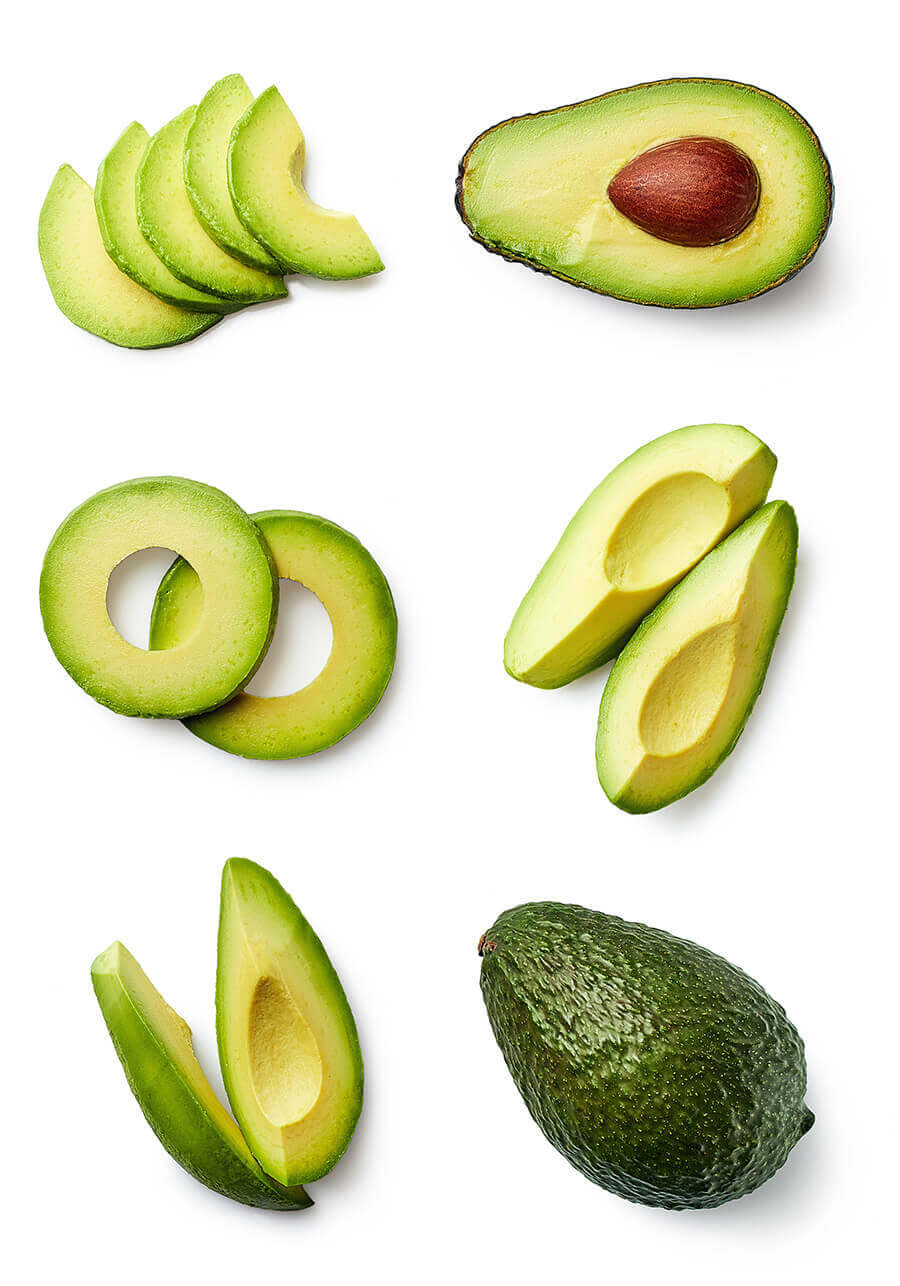Serving size is a standardized amount of food that represents the average amount of a food that was eaten during one meal/snack. The serving size is not a recommended amount of food to eat.
Portion size is the amount of food you choose to eat – which may be more or less than a serving.
While a serving of fresh avocados is 1/3 of an avocado (or 50 grams), your chosen portion size may vary based on individual dietary goals. Avocados are nutrient-dense, and you can use them in just about any diet — just adjust your portion size accordingly.

Avocado Serving and Portion Sizes
Like any other food, it’s essential to know about the standard serving and portion sizes of an avocado. Not only can you use this knowledge when making a recipe featuring avocados or in your general preparation of meals, but you can also use it to meet your nutritional goals and needs.
In this guide, we’ll discuss the serving and portion sizes of an avocado, why they matter, and how to use this knowledge to your advantage.
What’s the Difference Between Serving and Portion Sizes?
While people may use “serving size” and “portion size” interchangeably, the two terms are drastically different. For one, a serving size is a standardized amount of food. It represents the average amount of food that people typically eat. A portion size, on the other hand, is the amount you choose to eat in one sitting, which may be more or less than the official serving size.
Portion sizes are important to acknowledge when discussing the nutritional needs of an individual. Every person is different, which means that every person’s diet will be, and should be, different. For one, every individual has differing basal metabolic rates — the amount of energy or calories your body requires to maintain basic bodily functions like breathing, organ functioning, etc. This may vary depending on your genes, any healthy conditions you have, and your body composition. If you have a high basal metabolic rate, you may eat larger portions to meet your basic nutritional needs.
The amount of avocado you eat may also depend on your nutritional goals. For example, if you’re aiming to eat a more calorie-dense diet, your portion size may be bigger than someone who is aiming for a low-calorie diet.


Avocado Serving Size
The short answer is that a serving of fresh avocados is a third of an avocado, or 50 g, according to the USDA FoodData Central. A serving of avocado provides:
- 80 calories
- 3 g of fiber
- 6 g of unsaturated fats
- 0 g of added sugars, cholesterol, and sodium
- 1 g of protein

Avocado Portion Size
While a serving of fresh avocados is 1/3 of an avocado (or 50 grams), your chosen portion size may differ, depending on your personal preference, dietary goals, and health recommendations. It’s important to measure according to the correct portion size because a 1/4 of an avocado has 60 calories but the official serving size of 1/3 of an avocado has 80 calories. Here are some of the most common portion sizes and their nutritional information:

1 Serving
About 1/3 of an avocado
(50g / ~1.75oz)
| Calories | 80 |
| Total Fat | 8g |
| Saturated Fat | 1g |
| Trans Fat | 0 |
| Polyunsaturated Fat | 1g |
| Monounsaturated Fat | 5g |
| Cholesterol | 0 |
| Sodium | 0mg |
| Potassium | 250mg |
| Total Carbohydrate | 4g |
| Dietary Fiber | 3g |
| Total Sugars | 0 |
| Added Sugars | 0 |
| Protein | 1g |
| VITAMINS | |
| Folate (mcg or μg) | 45 |
| Niacin | 1mg |
| Pantothenic Acid | 0.7mg |
| Riboflavin | 0.1mg |
| Vitamin A (mcg or μg) | 0 |
| Vitamin B6 | 0.1mg |
| Vitamin C | 4mg |
| Vitamin E | 1mg |
| MINERALS | |
| Calcium | 10mg |
| Copper | 0.1mg |
| Iron | 0.3mg |
| Magnesium | 15mg |
| Manganese | 0.1mg |
| Phosphorus | 30mg |
| Zinc | 0.3mg |

.75 Serving
About 1/4 of an avocado
(37.5g / 1.25oz)
| Calories | 60 |
| Total Fat | 6g |
| Saturated Fat | 1g |
| Trans Fat | 0 |
| Polyunsaturated Fat | 0.5g |
| Monounsaturated Fat | 3.5g |
| Cholesterol | 0 |
| Sodium | 0mg |
| Potassium | 190mg |
| Total Carbohydrate | 3g |
| Dietary Fiber | 3g |
| Total Sugars | 0 |
| Added Sugars | 0 |
| Protein | 1g |
| VITAMINS | |
| Folate (mcg or μg) | 35 |
| Niacin | 0.7mg |
| Pantothenic Acid | 0.5mg |
| Riboflavin | 0.1mg |
| Vitamin A (mcg or μg) | 0 |
| Vitamin B6 | 0.1mg |
| Vitamin C | 3mg |
| Vitamin E | 0.7mg |
| MINERALS | |
| Calcium | 10mg |
| Copper | 0.1mg |
| Iron | 0.2mg |
| Magnesium | 10mg |
| Manganese | 0.1mg |
| Phosphorus | 20mg |
| Zinc | 0.3mg |

1.5 servings
About 1/2 of an avocado
(75g / 2.5oz)
| Calories | 130 |
| Total Fat | 12g |
| Saturated Fat | 1.5g |
| Trans Fat | 0 |
| Polyunsaturated Fat | 1.5g |
| Monounsaturated Fat | 7g |
| Cholesterol | 0 |
| Sodium | 5mg |
| Potassium | 380mg |
| Total Carbohydrate | 6g |
| Dietary Fiber | 5g |
| Total Sugars | 0 |
| Added Sugars | 0 |
| Protein | 1g |
| VITAMINS | |
| Folate (mcg or μg) | 65 |
| Niacin | 1.4mg |
| Pantothenic Acid | 1.1mg |
| Riboflavin | 0.1mg |
| Vitamin A (mcg or μg) | 10 |
| Vitamin B6 | 0.2mg |
| Vitamin C | 7mg |
| Vitamin E | 1.5mg |
| MINERALS | |
| Calcium | 10mg |
| Copper | 0.1mg |
| Iron | 0.5mg |
| Magnesium | 20mg |
| Manganese | 0.1mg |
| Phosphorus | 40mg |
| Zinc | 0.5mg |

3 Servings
About 1 whole avocado
(150g / 5oz)
| Calories | 250 |
| Total Fat | 23g |
| Saturated Fat | 3g |
| Trans Fat | 0 |
| Polyunsaturated Fat | 3g |
| Monounsaturated Fat | 15g |
| Cholesterol | 0 |
| Sodium | 10mg |
| Potassium | 760mg |
| Total Carbohydrate | 13g |
| Dietary Fiber | 10g |
| Total Sugars | 0 |
| Added Sugars | 0 |
| Protein | 3g |
| VITAMINS | |
| Folate (mcg or μg) | 135 |
| Niacin | 2.9mg |
| Pantothenic Acid | 2.2mg |
| Riboflavin | 0.2mg |
| Vitamin A (mcg or μg) | 10 |
| Vitamin B6 | 0.4mg |
| Vitamin C | 13mg |
| Vitamin E | 3mg |
| MINERALS | |
| Calcium | 20mg |
| Copper | 0.3mg |
| Iron | 0.9mg |
| Magnesium | 45mg |
| Manganese | 0.2mg |
| Phosphorus | 80mg |
| Zinc | 1mg |
Since avocados are so versatile, you can incorporate them into practically every meal. As you follow recipes that ask for different amounts of avocado, consider the amount you’re eating in each portion to meet your nutritional needs.
Adjusting Portion Sizes Based on Dietary Goals
Your portion size of avocado may change depending on your dietary goals. Here are some tips to keep in mind based on your needs:
Weight Loss
If weight loss is your goal, avocados can be a great addition to your meals — no matter what diet you’re on. For one, avocados have fiber — 65% of which is insoluble. This not only aids your digestion but also helps you feel full for a longer time.
Similarly, the 5 g of monounsaturated fats in a standard serving of avocado can also help lower LDL cholesterol levels, which can help reduce your risk of developing stroke. Avocados contain unsaturated fats and can be used as a replacement for butter or higher-fat cheese in recipes.
Both of these factors are essential in weight loss goals.
Heart Health
Avocados are a heart-healthy powerhouse, all thanks to their nutritional makeup. For one, a 50 g serving of avocado is a good source of fiber. By eating dietary fiber from fruit, as part of a heart-healthy diet, it can help reduce your bad cholesterol levels and lower your risk of developing heart disease.
Similarly, the 5 g of monounsaturated fats in a standard serving of avocado can also help lower LDL cholesterol levels, which can help reduce your risk of developing stroke. Avocados contain unsaturated fats and can be used as a replacement for butter or higher-fat cheese in recipes.
To maximize heart-health benefits, try incorporating avocado in place of saturated fats. Even starting with a standard serving size of 50 g in each meal can enhance the nutritional quality of your diet, whether that means spreading it on toast instead of butter or adding it to a salad instead of relying on oil-based dressings.
High-Calorie Needs
For individuals with higher calorie requirements, such as athletes, growing teens, people recovering from illness, or those trying to gain weight, avocados can be a nutritious and efficient way to increase energy intake.
In these cases, a larger portion size, such as ½ to a whole avocado per meal, can help meet increased energy demands while providing essential vitamins, minerals, and heart-healthy fats. Avocados are also easy to blend into calorie-rich meals: think smoothies, grain bowls, sandwiches, or pasta dishes. Their creamy texture enhances both flavor and nutrient density without relying on added sugars or saturated fats.
Avocados are also easy to blend into calorie-rich meals: think smoothies, grain bowls, sandwiches, or pasta dishes. Their creamy texture enhances both flavor and nutrient density without relying on added sugars or saturated fats.
How To Be Mindful of Avocado Portion Sizes
Being mindful goes beyond your daily decisions about what foods you eat and how much you eat. Being mindful can help you be more connected with your body and help you understand your hunger and fullness cues. A growing body of research around mindful eating — the practice of being aware of what food you’re eating, and how you feel before, during, and after eating — indicates that people may be more inclined to stay away from processed foods and use healthy eating practices, such as eating healthier foods like avocados.
The entire philosophy behind mindful eating isn’t about restriction. Instead, it’s about making informed choices about your diet that align with your health goals. Here are a few tips to get you started:
1
Use smaller plates and bowls like a salad plate instead of a dinner plate. The bigger the plate or bowl, the more food you’ll likely serve yourself. Smaller plates and bowls can also make your portion size appear larger and leave you feeling more satisfied.
2
Measure your food. Use a food scale or measuring cups to accurately portion out what the serving size looks like and give yourself an idea of that amount of food.
3
Pay attention to serving sizes. Read the nutrition label to understand the calories and other nutrients in the recommended serving size and adjust your portions accordingly. It’s important to remember that the serving size – either from a box or at a restaurant – may not necessarily be the amount of food you need.
4
Eat from a plate. Serve yourself a portion on a plate or in a bowl instead of eating straight from the container. It’s easy to eat more than one serving when eating straight from the box or bag.
5
Chew your food slowly and savor each bite. This helps you focus on enjoying what you’re eating and may help you feel more satisfied.
6
Pause and assess. Take a break midway through your meal to see if you’re feeling full or if you need more food.
7
Avoid distractions. Turn off screens while eating to allow for more awareness of what you are eating.
8
Listen to your body. Stop eating when you feel satisfied, not necessarily when your plate is empty.
Understanding the difference between serving size and portion size can help you enjoy avocados in a way that aligns with your needs, whether you’re aiming to lose weight, support heart health, or increase your daily calorie intake. No matter your dietary path, there’s room for this creamy, versatile fruit when you know how to make it work for you.
For more avocado-based recipes, check out Love One Today! We have a catalogue of meals featuring this versatile fruit so that you can enjoy its health benefits at any portion size.




